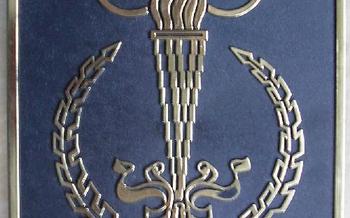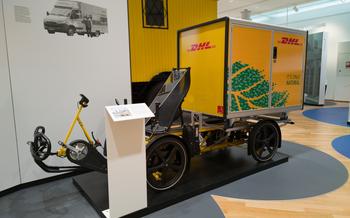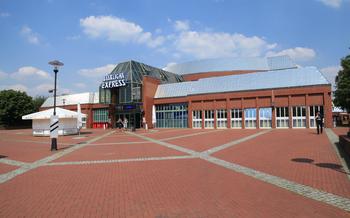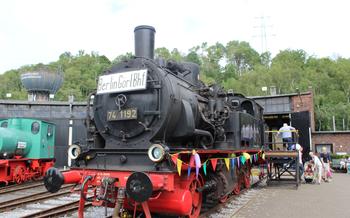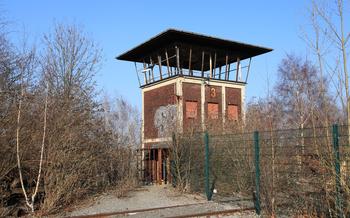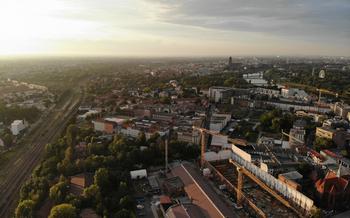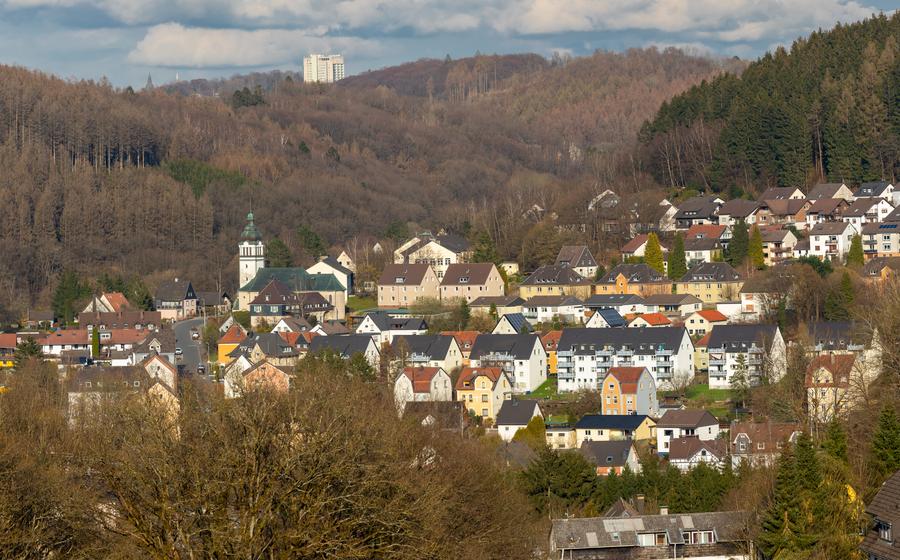
Deutsches Bergbau Museum Bochum
- A Trip Back in Time: The Deutsches Bergbau Museum Bochum
- Mining in Germany: A rich history
- The museum's exhibits: A comprehensive overview
- The Coal Mine: An immersive experience
- The Mining Technology Park: A hands-on experience
- The Mineralogical Collection: A World-Class Collection
- The Library and Archive: A Treasure Trove of Information
- The Education Center: A place to learn about mining
- The Museum Café: A Place to Relax and Refuel
- The Museum Park: A Place to Enjoy the Outdoors
- Planning your visit: Tips and advice
- Getting there: Directions and transportation
- Nearby attractions: What else to see and do in Bochum
- Insider Tip: A hidden gem
A Trip Back in Time: The Deutsches Bergbau Museum Bochum
The Deutsches Bergbau Museum Bochum is a world-renowned museum dedicated to the history and technology of mining. Located in the city of Bochum, in the heart of Germany's Ruhr region, the museum offers a comprehensive overview of the mining industry, from its humble beginnings to its modern-day practices.
The museum was founded in 1930 and has since grown into one of the largest and most important mining museums in the world. It houses a vast collection of artifacts, documents, and machinery, as well as a variety of interactive exhibits that bring the history of mining to life. The museum is divided into several sections, each focusing on a different aspect of mining. The permanent exhibits include the Coal Mine, the Mining Technology Park, the Mineralogical Collection, and the Library and Archive. The museum also hosts a variety of temporary exhibits and special events throughout the year.
Mining in Germany: A rich history
Mining has played a significant role in Germany's history and economic development. For centuries, the country was a major producer of coal, iron ore, and other minerals. Mining regions such as the Ruhr Valley and the Saarland were once home to thriving mining communities.
The different types of mining in Germany included underground mining, open-pit mining, and quarrying. Underground mining was the most common method, and it was used to extract coal, iron ore, and other minerals from deep underground. Open-pit mining was used to extract minerals from near the surface, and it was often used for coal mining. Quarrying was used to extract stone and other materials from the ground.
The major mining regions in Germany included the Ruhr Valley, the Saarland, and the Harz Mountains. The Ruhr Valley was the most important mining region, and it was home to some of the largest coal mines in the world. The Saarland was also a major coal mining region, and it was also home to iron ore and other minerals. The Harz Mountains were a major mining region for silver, lead, and zinc.
The decline of mining in Germany began in the 1950s. The main reason for the decline was the increasing cost of production. The cost of labor, machinery, and energy all rose, and this made it more expensive to produce coal and other minerals in Germany. The decline of mining also led to the loss of jobs and the decline of mining communities.
The museum's exhibits: A comprehensive overview
The Deutsches Bergbau Museum Bochum boasts a comprehensive collection of exhibits that offer a thorough overview of the history and significance of mining in Germany.
-
Permanent exhibits: The permanent exhibits delve into the various aspects of mining, from its humble beginnings to its modern-day applications. Visitors can learn about the different types of mining, the tools and techniques used, and the safety measures employed to protect miners.
-
Temporary exhibits: Temporary exhibits showcase specific aspects of mining or feature special collections. These exhibits offer visitors a fresh perspective on the industry and allow them to explore topics in greater depth.
-
Special exhibitions: Special exhibitions are organized on a regular basis and often feature unique artifacts or interactive displays. These exhibitions provide visitors with an opportunity to engage with the museum's collection in a new and exciting way.
-
Highlights of the collection: Among the highlights of the museum's collection are the original mining machinery, rare minerals, and historical documents. These artifacts provide a tangible connection to the past and help visitors understand the impact of mining on German history and culture.
The Coal Mine: An immersive experience
The Deutsches Bergbau Museum Bochum features a realistic recreation of a coal mine, offering visitors a unique opportunity to experience the conditions under which miners worked. The mine is complete with dark, narrow tunnels, coal seams, and mining equipment. Visitors can explore the mine on their own or take a guided tour to learn more about the history and technology of coal mining.
The coal mine exhibit is a popular attraction for visitors of all ages. It is a great way to learn about the history of coal mining and the challenges that miners faced. The exhibit is also a reminder of the importance of coal in Germany's past and present.
The Mining Technology Park: A hands-on experience
The Mining Technology Park is a unique opportunity to learn about the technology of mining. Visitors can see a variety of mining machines and equipment on display, and they can even operate some of the machines themselves. This is a great way to get a hands-on experience of what it is like to work in a mine.
The Mining Technology Park is located outdoors, and it is open year-round. Visitors can explore the park at their own pace, or they can take a guided tour. Guided tours are available in English and German, and they last for about an hour.
Some of the highlights of the Mining Technology Park include:
- A replica of a coal mine, which shows visitors what it was like to work in a mine in the 19th century.
- A variety of mining machines, including a coal cutter, a conveyor belt, and a drill.
- A hands-on area where visitors can operate some of the machines themselves.
The Mining Technology Park is a great place for people of all ages to learn about the technology of mining. It is also a great place to take a break from the hustle and bustle of the city and enjoy the outdoors. So if you are visiting the Deutsches Bergbau Museum Bochum, be sure to add the Mining Technology Park to your itinerary.
The Mineralogical Collection: A World-Class Collection
The Deutsches Bergbau Museum Bochum is home to a world-class mineralogical collection, with over 100,000 minerals from all over the world. The collection is divided into two parts: the systematic collection and the regional collection. The systematic collection is arranged according to the chemical composition of the minerals, while the regional collection is arranged according to the location where the minerals were found.
The mineralogical collection includes a variety of displays, including fluorescent minerals, gemstones, and meteorites. The fluorescent mineral display is particularly impressive, with minerals that glow under ultraviolet light. The museum also has a collection of over 500 meteorites, which are rocks that have fallen to Earth from space.
The mineralogical collection is a valuable resource for researchers and historians. It is also a great place to learn about the science of mineralogy. Guided tours of the collection are available in English and German.
The Library and Archive: A Treasure Trove of Information
The Deutsches Bergbau Museum Bochum houses an extensive library and archive, containing a vast collection of books, journals, and other documents related to mining. This treasure trove of information is a valuable resource for researchers and historians interested in studying the history of mining in Germany and beyond. The library's holdings include over 100,000 volumes, including rare books and manuscripts dating back to the 16th century. The archive contains a wealth of primary source material, such as mining plans, maps, photographs, and personal papers. Visitors can access the library and archive by appointment, and guided tours are available for groups. Whether you are a researcher, a historian, or simply someone interested in learning more about the history of mining, the Deutsches Bergbau Museum Bochum's library and archive are a must-visit.
The Education Center: A place to learn about mining
The Deutsches Bergbau Museum Bochum is not just a place to learn about the history and technology of mining; it is also a place to learn about the importance of mining to society. The museum's Education Center offers a variety of educational programs for all ages, from preschoolers to adults.
School groups are welcome at the museum, and the Education Center staff can tailor programs to meet the needs of specific groups. Programs can focus on a variety of topics, such as the history of mining, the different types of mining, the importance of mining to society, and the environmental impact of mining.
The Education Center also offers a variety of public programs, such as lectures, workshops, and family days. These programs are a great way for people of all ages to learn about mining in a fun and interactive way.
The Deutsches Bergbau Museum Bochum is a valuable resource for anyone who wants to learn more about mining. The museum's Education Center offers a variety of programs and resources that can help people of all ages to understand the importance of mining to society.
The Museum Café: A Place to Relax and Refuel
After exploring the vast exhibits of the Deutsches Bergbau Museum Bochum, visitors can rejuvenate and replenish at the inviting Museum Café. This delightful establishment serves a tempting array of culinary delights, catering to diverse tastes and preferences. Indulge in mouthwatering snacks, delectable pastries, and a variety of refreshing beverages, including aromatic coffees and invigorating teas.
The Museum Café offers a tranquil ambiance, providing a welcoming respite from the captivating museum displays. Its cozy seating arrangements and warm atmosphere invite visitors to linger, savor their refreshments, and engage in stimulating conversations. Whether seeking a quick bite or a leisurely break, the Museum Café offers a perfect sanctuary to unwind and recharge.
Patrons can choose to bask in the sun-kissed ambiance of the outdoor seating area, surrounded by the verdant greenery of the Museum Park. This alfresco setting offers a delightful opportunity to enjoy the fresh air while savoring delectable treats.
Proceeds generated from the Museum Café play a vital role in supporting the museum's ongoing initiatives, ensuring its continued excellence and preservation of Germany's rich mining heritage. By indulging in the culinary offerings of the Museum Café, visitors not only nourish their bodies but also contribute to the preservation of this cultural treasure.
The Museum Park: A Place to Enjoy the Outdoors
The Deutsches Bergbau Museum Bochum is not just a place to learn about mining; it's also a place to relax and enjoy the outdoors. The museum park is a beautiful green space with a variety of trees and flowers. It's a great place to take a stroll, relax on a bench, or let the kids run around. There are also picnic tables available, so you can pack a lunch and enjoy a meal in the park.
The park is a great place to visit in the summer, when the flowers are in bloom and the weather is warm. It's also a nice place to visit in the fall, when the leaves are changing color. No matter what time of year you visit, you're sure to enjoy the beauty of the museum park.
Here are some tips for enjoying the museum park:
- Bring a blanket or a chair to sit on.
- Pack a lunch or snacks to eat in the park.
- Bring a camera to take pictures of the flowers and the scenery.
- Let the kids run around and play on the playground.
- Visit the park in the morning or evening to avoid the crowds.
Planning your visit: Tips and advice
To make the most of your visit to the Deutsches Bergbau Museum Bochum, it is important to plan ahead. Here are a few tips to help you make the most of your experience:
-
Allow plenty of time to explore the museum. There is a lot to see and do at the museum, so it is important to allow plenty of time to explore. Plan to spend at least three hours at the museum, and more if you are interested in taking a guided tour.
-
Wear comfortable shoes. You will be doing a lot of walking at the museum, so it is important to wear comfortable shoes.
-
Bring a camera. There are many photo opportunities at the museum, so be sure to bring a camera to capture your memories.
-
Check the museum's website for special events. The museum often hosts special events, such as lectures, workshops, and demonstrations. Check the museum's website for a list of upcoming events.
-
Consider booking a guided tour. Guided tours are available in English and German. Tours last about two hours and cover all of the major highlights of the museum.
Getting there: Directions and transportation
The Deutsches Bergbau Museum Bochum is located at Herner Straße 149, 44791 Bochum, Germany.
By car: Take the A40 motorway to the Bochum-Zentrum exit. Follow the signs to the museum. There is a large parking lot adjacent to the museum.
By public transportation: Take the U35 subway line to the Bochum-Zentrum stop. The museum is a short walk from the station.
Parking: There is a large parking lot adjacent to the museum. The parking fee is €5 per day.
The museum is wheelchair accessible.
Nearby attractions: What else to see and do in Bochum
Bochum, a city with a rich industrial history, offers a variety of attractions for visitors interested in mining, culture, and nature. In addition to the Deutsches Bergbau Museum Bochum, here are a few other places worth exploring:
-
The Jahrhunderthalle Bochum: This former coal mine has been transformed into a cultural center, hosting concerts, exhibitions, and other events. Its striking architecture and unique history make it a must-see for anyone visiting Bochum.
-
The German Mining Museum: Located in the city center, this museum tells the story of mining in Germany, from its early days to the present. With interactive exhibits and guided tours, it's a great place to learn more about the industry that shaped Bochum's history.
-
The Bochum Botanical Garden: Escape the hustle and bustle of the city in this beautiful garden, home to a diverse collection of plants from around the world. With its peaceful atmosphere and picturesque scenery, it's the perfect place to relax and unwind.
-
The Ruhr Park: For those who love to shop, the Ruhr Park is a must-visit. With over 200 stores, including many international brands, it's one of the largest shopping malls in Germany.
Insider Tip: A hidden gem
The Deutsches Bergbau Museum Bochum is home to one of the world's finest mineralogical collections, a hidden gem that is sure to amaze visitors of all ages. With over 100,000 minerals from every corner of the globe, the collection is a testament to the diversity and beauty of the natural world.
One of the highlights of the collection is the fluorescent mineral display. These minerals, which emit a brilliant glow when exposed to ultraviolet light, are a mesmerizing sight to behold. Visitors can also learn about the science of mineralogy and the importance of minerals in our everyday lives.
Whether you're a seasoned mineralogist or simply someone with an appreciation for the beauty of nature, the Deutsches Bergbau Museum Bochum is a must-visit destination. Guided tours are available in English and German, ensuring that visitors from all over the world can learn about the fascinating world of minerals.
